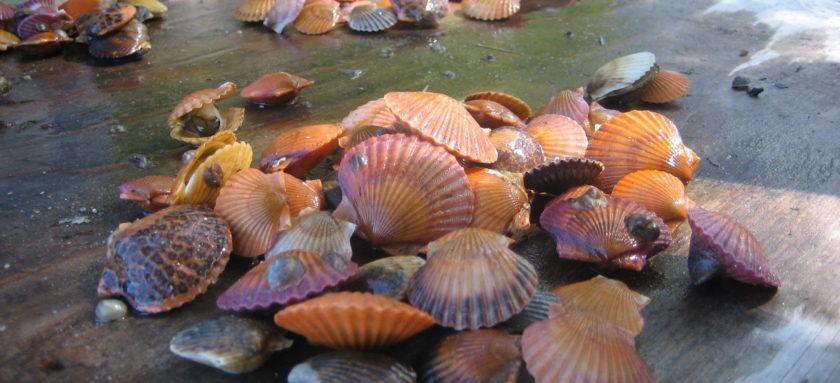Protecting & Restoring Long Island's Peconic Bays
Shellfish restoration efforts have resulted in a resurgence of the iconic Long Island bay scallop.

The bay scallop, Argopecten irradians, is an iconic species on Long Island. It is the object of a prized recreational and commercial fishery, commanding a price as high as $30 per pound!
The bay scallop also has a pretty unique biology. Bay scallops are functional hermaphrodites, alternatively releasing eggs and sperm during a single spawning event. In the Peconic Bays, spawning typically is initiated between late May and mid-July, but may occur as late as September-October. After successful fertilization takes place, scallop larvae typically float around in the water for about two weeks before attaching to above-bottom substrates. Historically, eelgrass has been viewed as their preferred above-bottom habitat, but in the Peconic Bays they will settle on several submerged aquatic vegetation species, as well as shells, stones and man-made materials. While scallops remain attached above the bottom, a spatial refuge is provided from many of their common predators (crabs, whelks, oyster drills, sea stars). Unlike most other shellfish, bay scallops also have the ability to swim, by ‘clapping’ their two valves and shooting jets of water, to propel themselves to safety from predators.
Bay scallops usually spawn during the first year of their life cycle, but most live through the fall and winter before they die of natural causes at an age of 18-22 months. This is very advantageous for the fishery because adult scallops can typically be fished without the need for catch restrictions, since the great majority of these scallops will die anyway if they are not caught. This life history, however, makes bay scallop populations and annual fishery landings prone to dramatic fluctuations.
In 1985, the first of a series of brown tide algal blooms occurred in Long Island waters, decimating bay scallop populations.
Historically, commercial landings of bay scallops in New York were common in Long Island Sound and embayments all over Long Island. However, in the 1930’s, eelgrass wasting disease devastated the scallop’s preferred habitat and scallop populations declined dramatically. Then in 1985, the first of a series of brown tide (Aureococcus anophagefferens) algal blooms occurred in Long Island waters, decimating bay scallop populations. Fishery landings declined from an annual average of 300,000 lbs to approximately 300 lbs in 1987-1988. Restoration efforts in the Peconic Bays were initiated in 1986 and scallop populations rebounded for a few years in the late 1980’s-early 1990’s. However, a severe brown tide in 1995 again decimated their population. The total New York commercial harvest in 1996 was a mere 53 lbs.
In 2006, intense restoration efforts by Long Island University and Cornell Cooperative Extension began with the aim of jump starting the bay scallop population.
In 1997, the East Hampton Town Shellfish Hatchery initiated restoration efforts. However, bay scallop population remains at low levels, despite the absence of brown tide blooms in the Peconic Bays and seemingly favorable water quality. In 2006, intense restoration efforts by Long Island University and Cornell Cooperative Extension began with the aim of jump starting the bay scallop population, by planting several million hatchery-reared bay scallops at high densities in nets and directly to the bay bottom. This strategy was designed to ensure a high probability of fertilization success upon spawning (poor fertilization success was hypothesized to be the reason that scallops populations had not recovered).

In 2008, the first benefits of restoration finally became evident. Landings in 2014 and 2015 were 88,500 and 60,000 lbs, respectively, representing the two highest annual landings since 1994. Fishery revenues and economic benefits to the regional economy also increased by $4 million and $40 million, respectively. Analyses indicate that the resurgence of the Peconic bay scallop population since 2007 was driven by the intensive restoration efforts.
But there is still more work to do! If we want to see the Peconic bay scallop population continue to surge, we need to protect the water quality of the Peconic and work to restore valuable submerged aquatic vegetation habitat.
Learn about the priority issues affecting the Peconic Estuary and what PEP is doing to address them here.
Sign up for News, Events and Information straight to your inbox.
